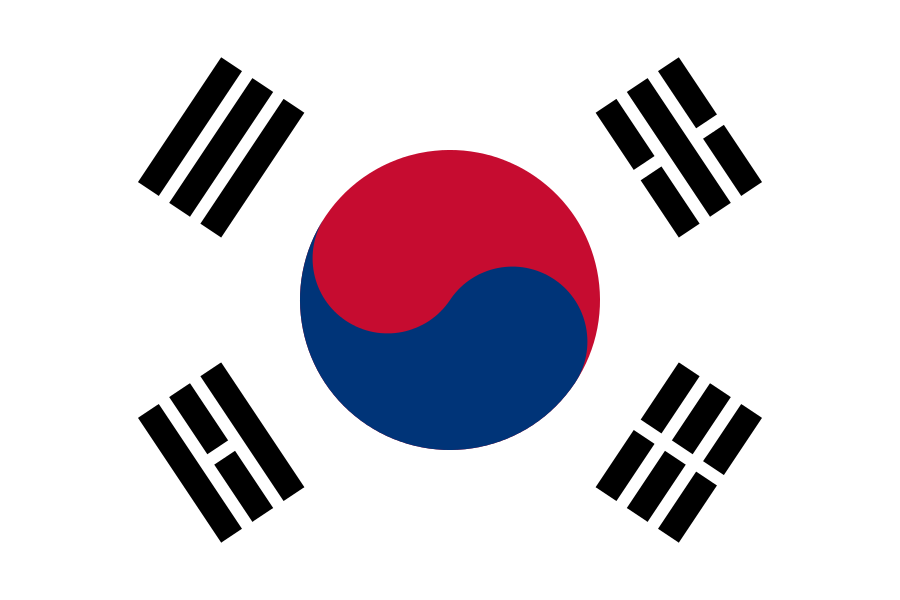1. Taegeuk (Yin and Yang Symbol):
The central motif of the South Korean flag, the Taegeuk, stands as a visual representation of the eternal rhythm of creation and transformation. This dynamic emblem embodies the harmonious dance between contrasting forces that define existence.
The Taegeuk is divided into two distinct yet interconnected halves, reflecting the principles of Yin and Yang. The blue sector, known as "Eum," embodies qualities of coolness, darkness, receptivity, and serenity. It evokes the vast expanse of the cosmos and represents the unseen depths of existence. On the other hand, the red sector, termed "Yang," embodies warmth, brightness, energy, and vitality. It signifies the tangible, active, and creative aspects of the universe.
The interaction between these two halves is not one of opposition, but rather of symbiosis. The swirling motion of the Taegeuk signifies the constant interplay and balance between these opposing yet complementary forces. The Taegeuk serves as a metaphor for the continuous ebb and flow of cosmic energy, reflecting the timeless rhythm of life's cycles.
2. Four Trigrams (Gwaebul):
Surrounding the Taegeuk are four distinct trigrams, each formed from combinations of solid and broken lines that represent the duality of Yin and Yang. These trigrams hold deep symbolic significance:
- The upper left trigram, representing "Cheon," encapsulates heaven and the energy of the East. It symbolizes growth, new beginnings, and the realm of the spiritual.
- The upper right trigram, signifying "Gam," embodies water and the qualities of the West. It is associated with introspection, adaptability, and the nurturing aspects of life.
- The lower left trigram, known as "Ri," represents fire and the South. It embodies passion, illumination, and the vibrant energy of the sun.
- The lower right trigram, representing "Gon," signifies earth and the North. It symbolizes stability, groundedness, and the nurturing qualities of the land.
- Together, these trigrams form a harmonious balance that reflects the interconnectedness of the elements and their influence on the cardinal directions.
3. Colors and Symbolism:
The flag's colors are pivotal to its symbolism:
- The pristine white background represents purity, integrity, and the collective aspiration for unity and harmony.
- The blue of the Taegeuk embodies the celestial realm, aspiration for spiritual growth, and the unbounded potential of the infinite.
- The red sector symbolizes the terrestrial sphere, pulsating with life's vitality, passion, and the urge to create and transform.
- The black trigrams serve as a poignant reminder of the inseparable nature of opposing forces, offering a dynamic equilibrium that nurtures wisdom and understanding.
4. Historical Significance:
The South Korean flag's origins trace back to 1882 when King Gojong and his advisors conceptualized the design, rooted in both Eastern philosophy and Korea's rich cultural heritage. This emblem underwent several revisions over time to mirror shifts in governance and political ideologies. On October 15, 1949, it was formally adopted as South Korea's national flag.
5. Modern Context:
Today, the flag stands as a potent emblem of national pride and unity, cherished by South Koreans both within their homeland and around the world. Its display during national events, celebrations, and holidays reinforces the spirit of the Korean people and their profound cultural legacy. The Taegeukgi offers a visual embodiment of the significance of equilibrium, collaboration, and serenity, advocating their value in both individual and societal realms.
In summary, the South Korean flag, known as Taegeukgi, is an intricate embodiment of Korea's philosophical depth, cultural richness, and historical legacy. Its design symbolizes balance, harmony, and unity, mirroring the interplay of opposites within the vast tapestry of existence. The flag's profound symbolism and historical weight serve as an enduring representation of Korea's identity and values.
Last Updated on: November 13, 2025
